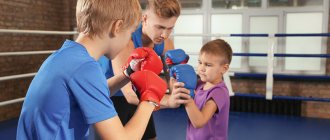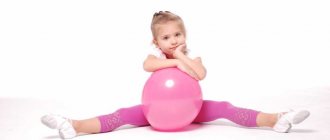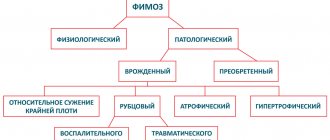Is it necessary to send a child from 3 to 12 years old to the section?
When deciding to send your child to sports, you should take into account his desire, age, physical characteristics and abilities. If a boy has serious health problems, it is better to limit himself to physical therapy and engage in professional sports with caution, after the permission of the attending physician.
Playing sports at a young age has a number of advantages:
- The general condition of the body improves.
- The frequency of colds is reduced.
- The muscle corset is strengthened, the child becomes strong and resilient.
- Coordination of movements and dexterity develops.
- Positive personal qualities are cultivated: willpower, the ability to work hard and achieve a certain goal.
- The boy becomes more disciplined and a strong character is formed.
- The emotional background improves, the nervous system is strengthened, the child tolerates stress more easily and worries less about trifles.
- A constant flow of oxygen has a beneficial effect on the brain and mental abilities.
- The number of social contacts increases, more friends appear.
- Sports distract boys from gadgets and computer games.
- The child is constantly busy, the risk of falling into bad company is minimal.
How to choose a sports section for a girl or a boy, taking into account the characteristics of the child’s physical development at a given age.
Sports sections for boys or close to them have a number of disadvantages:
- High chance of injury.
- Heavy stress on the body.
- Professional sports require full dedication, to the detriment of basic studies at school.
- The need to constantly attend training camps, championships, competitions in other cities.
- Large financial investments from parents, especially on uniforms and necessary equipment.
Temperament correction
Parents often reason like this: if a child is too active, they need to take him to active sports - team and team sports, and send the fighter to the wrestling section so that he does not wave his fists at school.
“There is no direct connection between temperament, character and inclination towards a particular sport,” says Avdeeva. – If a child is active and loves to play chess, then it is absolutely not contraindicated for him to play it. It's optimal if you have both. You can play chess at home, gradually teaching him to sit quietly and think. But there is no need to forcefully plant, otherwise he will become disgusted.
What are the benefits of team sports? They contribute to the development of self-control and self-regulation. The child not only loses energy, but receives emotional release and learns to act purposefully. In general, any sport, if practiced regularly, teaches you to achieve results and overcome yourself. And overcoming oneself increases resilience.” According to the psychologist, young people are now drawn to sports not only for the sake of health and a beautiful figure, but because it perfectly relieves stress, which is quite strong in the city.
“A child accustomed to sports will have a skill for life: I’m not very well now, but I know how to help myself - go to the gym, do exercises, go for a run in the park.”
Article on the topic
Pitch per million. How much does it cost to train a young tennis player in Russia?
Basic principles for choosing a mug for a boy
Experts do not recommend sending a child to a section under 3 years of age. At the age of 3-4, if you really want to, you can enroll in 1, maximum 2 clubs.
Principles for choosing a section for a boy 3-4 years old:
- Sign up for any one club, otherwise your child will get very tired and will eventually lose interest in sports.
- It is best to give preference to the nearest sports club so that it is convenient to get there.
- Ask your child if he is interested in a certain sport, based on his preferences. The problem is that young children do not know the main sports areas well and may make the wrong choice.
- Pay attention to the boy’s natural characteristics.
- To start a professional sports career, 3-4 years is the ideal age. This is especially true for hockey, figure skating or gymnastics.
Principles for choosing a circle for a child 5-7 years old:
- At this age, children already have a better understanding of sports and their own preferences. Parents should listen not to their unfulfilled dreams, but to the wishes of their son.
- You should not choose a section on the other side of the city, especially if the journey will take more than an hour.
- 5-6 years is the right time to start playing team sports: football, volleyball, basketball and oriental martial arts: karate, judo.
Sports sections for boys aged 10-12 years:
- Young men who decide to take up sports in adolescence have an idea of what they want. Parents should not make a decision on their own; they can only suggest or recommend a sport.
- The question of a professional career in most sports is no longer an issue, with the exception of weightlifting, rowing or fencing.
- Teenagers engage in cycling and sports tourism with great pleasure.
How to help your child choose a section and what to consider first:
- The choice of the child himself, his preferences and interests.
- Natural abilities and data, predisposition to certain sports.
- Temperament type. Team sports are suitable for energetic and impulsive extroverts, while tennis or swimming are suitable for calmer, shy introverts.
- Physical imperfections that can be corrected through sports. For example, dancing, swimming and gymnastics perfectly straighten your posture, and football eliminates flat feet.
- It is better to choose a section or sports school that the child can get to independently, without the help of public transport.
- The personality of the coach plays a huge role. A competent mentor will reveal the potential of his student and instill a love of sports for life, but an incompetent specialist can cause real harm to health.
- The cost of visiting the section should be acceptable for parents.
Features of a boy’s health when choosing a section
In any sports section for children, before enrolling, parents must be required to provide a certificate of their son’s health. A special load during sports training always falls on the cardiovascular system, so an ECG is necessary. If this aspect of the boy’s health is not all right, then sports such as swimming, figure skating, tennis, football, and hockey may simply not be allowed.
For scoliosis and flat feet, it is better to choose sections that will help strengthen the muscle frame and correct these problems. For example, swimming and horse riding. But all jumping and running, as well as weight lifting types of physical activity should be excluded.
Team sports
Team sports for boys are considered the most preferable. Volleyball, basketball and football harmoniously develop the child's body, coordination and reaction, teach him discipline and teamwork.
Football
Children from 3-4 years old are accepted into the football section. Experts say the optimal age to start training is 6-7 years. It is better to start studying already having certain inclinations and type of temperament.
If the boy is fast, active, restless, sociable and temperamental, you can safely send him to the section. Introverted, slow, overweight children are better off choosing another option, otherwise there is a risk of instilling an aversion to sports.
Basketball
Basketball is one of the popular sports for boys that trains both physical strength and mobility. The section accepts children from 5 years old to have more time to study the features of the technology. But for classes you need good physical development, so the most optimal age to start classes is 8 years.
This sport requires not only the ability to be part of a team, but also a certain amount of discipline. It is not enough to go to training here; regular independent work in the form of daily jogging and warm-up is required.
Volleyball
Volleyball is a sport loved by many pediatricians for its uniform load on all muscle groups. As a result, the athlete’s body develops harmoniously. Boys are accepted into sports sections from the age of 8, but you can start training in adolescence.
List of contraindications for team sports:
- heart and vascular diseases;
- bronchial asthma;
- problems with spine, bones, joints;
- diseases of the gastrointestinal tract;
- other serious chronic pathologies.
The main advantages of team sports:
- Development of all physical skills necessary in sports and everyday life: strength, coordination, flexibility, dexterity, reaction speed.
- All team sports provide the most powerful cardio training for the body. The child becomes strong and resilient and suffers from colds less often.
- Availability and prevalence make it possible to practice even in the smallest localities.
- The variety of combinations during the game requires children to apply mental effort and constantly analyze the situation, which has a beneficial effect on intellectual development.
- Developing communication skills, the child becomes more sociable and learns to work in a team.
Flaws:
- It's easy to get injured.
- Not suitable for withdrawn children as it requires constant interaction with others.
- The interests of the team are placed above the interests of the individual.
At what age is it better to send a child to sports?
When should you send your son or daughter to sports? – It is best to start teaching children about sports from preschool age, but this is not always possible - young children are not accepted into all sports sections.
If parents plan to subsequently make sports a significant part of their child’s life, they need to teach their children to sports from the cradle. How to do it? Set up a small sports corner at home with a wall bars, a rope and other equipment. By exercising from early childhood, a child will overcome fear, strengthen some muscle groups, master existing equipment, and feel pleasure and joy from the activity.
- 2-3 years. Children at this age are full of energy, active and mobile. That is why at this time it is recommended to do gymnastics with children every day. Kids get tired quickly, so classes should not be long, just do a few simple exercises (claps, swinging your arms, bending, jumping) for 5-10 minutes;
- 4-5 years. This age is especially noteworthy because the baby’s body type has already been formed (as well as his character), and his talents are just beginning to emerge. This period is most suitable for finding a suitable sports club for your child. This age is good for developing coordination. Offer your child a choice of acrobatics, gymnastics, tennis, jumping or figure skating. From the age of five you can start classes at a ballet school or try your hand at hockey;
- 6-7 years. An excellent time to develop flexibility and plasticity. Within a year, the joints will reduce their mobility by about 20-25%. You can send your child to any type of gymnastics, swimming, start martial arts or football;
- 8-11 years old . This age period is best suited for the development of speed, agility and dexterity in a child. A great idea is to take him to rowing, fencing or cycling;
- From the age of 11, you should focus on endurance. Children after 11 years of age are able to withstand heavy loads, master complex movements and hone them. Choose any sports with a ball, consider athletics, boxing, shooting as options;
- After 12-13 years , the age comes when the optimal solution will be training aimed at developing strength and endurance.
So at what age can you enroll your child in one sport or another? There is no definite answer here, since each person is individual. There are children who, at the age of three, can skateboard or ski. Others are completely unprepared for most sports even by the age of nine. .
There are general recommendations that you should listen to when choosing a sports section. For example, classes to develop flexibility should start from an early age, since at this time the child’s body is more pliable for stretching. With age, flexibility decreases. But as for endurance, it, in general, develops gradually - from 12 years to 25.
If you decide to send a three-year-old child to a sports club, then take into account that the child’s bones and muscles will only be fully formed by the age of five. Excessive loads before this age can lead to unpleasant consequences, for example, scoliosis. For children under 5 years old, light exercise and active games are actually enough.
Which sections accept children at different ages?
- 5-6 years . Accepted for various types of gymnastics and figure skating;
- 7 years . Acrobatics, ballroom and sports dancing, martial arts, swimming, darts, as well as checkers and chess;
- 8 years . At this age, children are taken to badminton, football, basketball and golf. There is an opportunity to learn alpine skiing;
- 9 years . From now on, there is a chance to become a speed skater, master sailing, take up rugby and biathlon, and start athletics;
- 10 years . Upon reaching 10 years of age, children are accepted into boxing and kickboxing, pentathlon, and judo. You can send your children to weight training, billiards and cycling;
- From the age of 11, children are taken to sections for various types of shooting;
- From the age of 12, a child will be accepted into bobsleigh.
Types of sports for children and the age in years at which they are allowed to participate in sports school
Gifted children can be enrolled in the sports section one year younger.
We choose a sport, taking into account the child’s physique
Having decided to send your child to sports, you should pay attention to his body type. This is important because different sports take into account different body structure features. Tall height is preferred for basketball, while this feature is not valued in gymnastics. If a child is inclined to be overweight, parents should pay even more attention to the choice of direction in sports, because the results of training, and therefore the level of children’s self-esteem, will depend on this. Being overweight, a child is unlikely to become a good striker in football, but he will be able to achieve results in judo or hockey.
There are several types of body structure, according to the scheme used in medical practice by Stefko and Ostrovsky. Let's look at them in detail:
- Asthenoid type - this body type is characterized by pronounced thinness, the legs are usually long and thin, and the chest and shoulders are narrow. The muscles are poorly developed. Often, people with an asthenoid body type exhibit a stooped posture along with protruding shoulder blades. Such children tend to feel awkward. Considering these factors, it is important for parents to find a section where their child will be comfortable psychologically. What is important here is not only the direction in the sport itself, but also a suitable team. It is easy for such children to engage in gymnastics, basketball, as well as any sports where the emphasis is on speed, strength and endurance - skiing, cycling, jumping, rowing, throwing, golf and fencing, competitive swimming, basketball, rhythmic gymnastics.
- The thoracic body type is characterized by equal width of the shoulder girdle and hips, the chest is often wide. The rate of muscle mass development is average. These children are highly active and are suitable for sports that involve speed and develop endurance. Active children are suitable for various races, motorsports, skiing, and they will make excellent football players and biathletes, acrobats and figure skaters. You can send a child with this body type to ballet, capoeira, jumping, or get them interested in kayaking.
- The muscular type of build is typical for children with a massive skeleton and developed muscle mass. They are resilient and strong, which means they should choose a sport aimed at developing strength and speed. Such children can prove themselves in mountaineering, martial arts, football, powerlifting, take up water polo and hockey, and also achieve good results in weightlifting and WorkOut.
- Digestive type – the digestive body type is characterized by short stature, broad chest, the presence of a small tummy and fat mass in other parts of the body. These guys are not very agile, they are slow and clumsy. However, this does not mean that he cannot join the sport. To instill in them an interest in activities, choose weightlifting, shooting, hockey, athletic gymnastics, consider martial arts or motorsports, throwing and WorkOut as an option.
How to choose a sport, taking into account children's temperament?
Character also matters when choosing sports. It depends on him what success the child can achieve. For example, children with a high degree of activity are unlikely to be able to excel in sports where training is an endless series of repetitive exercises that require the ability to concentrate. They need to choose activities where the child can throw out excess energy, preferably a team sport.
- Sports for sanguine people. Children with this type of temperament are leaders by nature, they are not inclined to give in to fear, they like extreme sports, sports are suitable for them, where they can demonstrate all these qualities and show their own superiority. They will feel comfortable in fencing, mountaineering, and karate classes. Sanguine people will enjoy hang gliding, alpine skiing, and kayaking.
- Cholerics are emotional people, but they are able to share victory with someone, so children with this temperament are better off finding themselves in team sports. Wrestling or boxing is a good option for them.
- Phlegmatic children tend to achieve good results in everything, including sports, because their natural qualities are perseverance and calmness. Invite a child with such a temperament to take up chess, figure skating, gymnastics, or become an athlete.
- Melancholic children are very vulnerable children; they can be hurt by the coach’s excessive severity. It is better to choose one of the team sports for them or take them to dance. Horseback riding is a great option and is suitable for everyone, but shooting or sailing are also worth considering.
Which section should children be sent to, taking into account their state of health?
If you have chosen a direction in sports for your children, taking into account all the factors - their preferences, body type, character, then now you should pay attention to the health of future athletes. It is better to consult a pediatrician who knows the characteristics of the child’s body. The doctor will tell you which sports are contraindicated in each specific case, and which will be beneficial. The pediatrician will determine what level of exercise is appropriate for your children. Let's consider recommendations regarding the choice of sport for various diseases.
- Volleyball, basketball and football are contraindicated for myopic children, as well as those who suffer from asthma or flat feet. But these sports will help strengthen the musculoskeletal system;
- Rhythmic gymnastics will relieve the child of flat feet and help strengthen the back muscles, form beautiful posture;
- Swimming is suitable for all children without exception. Exercises in the pool have a beneficial effect on the muscles of the whole body, including the back, and strengthen the nervous system;
- Hockey is contraindicated if the child has chronic diseases, but he develops the respiratory system well;
- Martial arts, rhythmic gymnastics, skiing and figure skating are indicated for poorly developed vestibular apparatus;
- If you have a weak nervous system, children's yoga, swimming and horseback riding are suitable;
- Tennis is worth playing to develop fine motor skills and attention, but this sport is not suitable for nearsighted children and those who suffer from stomach ulcers;
- Horseback riding is recommended for convulsive syndrome, diseases of the gastrointestinal tract and diabetics;
- You can strengthen your heart and respiratory system by doing speed skating, athletics or diving ;
- Figure skating is contraindicated in cases of severe myopia and pleural diseases.
If you want to introduce children to sports, you should not be afraid of experiments, there will be victories, and there will be failures. However, never attribute your child’s failures in sports to various circumstances, because they are the result of the efforts made. Having achieved success through their efforts, children will again strive for victories; when faced with failure, they will begin to make more efforts.
Any sport is useful and important, because it develops strong character, responsibility and discipline. The main thing is that the child enjoys doing it!
Read also: TOP 10 types of sports and sports entertainment for children from 0 to 5 years old
Martial arts
Karate, boxing, freestyle wrestling, judo are classes for growing men. During training, boys learn to protect themselves and their loved ones, to be strong, calm and courageous. Oriental martial arts, which include not only fighting techniques and physical exercises, but also a unique philosophy, stand out in particular.
Karate, aikido, wushu, freestyle and Greco-Roman wrestling can be practiced from preschool age. Boxing and other sports where opponents methodically strike each other should be started no earlier than adolescence.
Contraindications to martial arts: all serious chronic diseases of the heart and musculoskeletal system.
The main advantages of this sport:
- Development of strength, agility, reaction.
- The child becomes more responsible and disciplined.
- Suitable for timid and shy boys, since training develops the ability to stand up for themselves. Physically weak people should not take up boxing or kickboxing; it is better to pay attention to martial arts, especially wushu.
- For children prone to aggression, wrestling will help them find an outlet for negative energy and become calmer.
- Overweight boys quickly get rid of unnecessary pounds.
Flaws:
- High risk of serious injury.
Which sports section should a boy be enrolled in, taking into account his physique and temperament?
In order for a child not just to play sports solely for his own and “mother’s” pleasure, but to be able to show good results, one must take into account his physical and psycho-emotional characteristics.
Body type:
- Asthenic boys have a thin physique with long limbs and weakly defined muscles. Therefore, when choosing a section, you need to pay attention to those that train mobility, endurance, and flexibility. For example, this is swimming or ballet.
- With the thoracic type, children are physically strong, active, with good muscle mass. Football, hockey and figure skating would suit them perfectly.
- “Strong ones” with a large skeleton belong to the muscular type. Parents should send them to the type of martial arts their child likes.
- Boys who are not very active, as a rule, are overweight - this is a digestive body type. They don’t like sports a priori, but they especially need it. Therefore, you need to start with simpler disciplines that help you relax, for example, swimming, gymnastics, running, cycling.
Height is also taken into account, because a short boy is more comfortable wrestling than playing basketball.
The temperament of the future man also plays an important role. Hyperactive children who have a lot of energy should take part in active sports. For quiet and shy boys, we can recommend team games, where they will not be leaders, but excellent members of a single whole team.
Swimming
Sports or dance sections for boys have an impressive number of health restrictions. Swimming is a rare exception to this rule. Regular exercise in the pool is equivalent to physical therapy. But, if a child decides to become a professional swimmer, he should not have chronic diseases.
You can start going to the pool from the age of 2-3, but only with your mother or trainer. From the age of 5 they begin intensive training.
Contraindications:
- allergic reactions, atypical dermatitis;
- skin and venereal diseases;
- chronic otitis, sinusitis.
Advantages:
- During swimming, all major muscle groups are used, the child becomes stronger and more resilient.
- Training can solve many health problems, strengthens the immune system, cardiovascular, nervous and respiratory systems.
- Swimming has a beneficial effect on the spine, relieving excess stress and improving posture.
- Overweight boys quickly lose weight.
- The emotional state is normalized, the destructive effects of stress on the body are neutralized.
- Suitable for restless, hyperactive and aggressive children, making them calmer.
- For weak and sickly young men, swimming helps them get stronger physically and become more self-confident.
- Improves sleep and appetite.
- With regular training, boys develop a correct masculine figure with broad shoulders and developed arm muscles.
- Ideal for introverted children focused on personal progress.
Flaws:
- If the pool area is not regularly disinfected and the optimal air and water temperatures are not maintained, there is a chance of developing chronic diseases of the upper respiratory tract (rhinitis, tracheitis).
- If there is a high chlorine content in the water, allergic reactions are possible.
- For classes you need to purchase swimsuits, caps and children's swimming goggles.
Choosing a section for a boy based on body type
Digestive physique
The digestive figure in boys is characterized by a significant width of the chest, short stature, excess fat and the presence of a noticeable rounded abdomen. Such children are usually inactive and very slow. In order to introduce an overweight boy to physical education, he should start working out, weightlifting, martial arts, shooting, hockey, or stop at strength gymnastics (if gym classes are not suitable, then you can master motorcycle sports).
Asthenic physique
Boys with an asthenoid body type have a narrow chest, prominent shoulder blades, often a slight stoop of the back, thin long legs, and undeveloped muscles. The overall impression is of a weak and thin body. Such a child must be properly introduced to the world of sports so that he feels comfortable even with his thin physique.
First of all, a psychologically favorable microclimate must be created in the section. For an asthenic boy, directions will be suitable that will help him become resilient, fast and strong. This could be rhythmic gymnastics, playing basketball, fencing (other options outside the gym are rowing, swimming, cycling, skiing, golf).
Muscular physique
Boys with a muscular body type have a heavy skeletal system and significant muscle mass by nature. They are very resilient and strong. The task of the section for such a child is to develop his speed.
In addition, strength training will do. Options for sections that a boy with developed muscles will successfully attend are football, capoeira, powerlifting, workout, fencing, various types of martial arts (there are options outside the gym - this is hockey, mountaineering, water polo.)
Thoracic physique
Children with a thoracic body type have a wide chest, moderately developed muscles, shoulders and pelvis of the same width. Such boys have a high level of activity. Sports activities are chosen for them, with the help of which they can increase their reaction speed and become more resilient. In this case, capoeira, ballet, kiting, football, acrobatics are suitable (more interesting options for classes take place not in the gym, but in other conditions - these are kayaking, swimming, rowing, figure skating, biathlon).
Gymnastics
Gymnastics is considered unsuitable for young men, which is not the case. This sport develops strength and agility no worse than football or basketball.
Sports sections accept 3-4 year old boys, but the most optimal age to start classes is 5 years old. The deadline for professional studies is 8 years; later, success and serious achievements will no longer be achieved. When recruiting for this section, preference is given to short, thin boys with flexible joints and ligaments.
Contraindications:
- serious diseases of the spine, bones, ligaments, joints;
- abnormalities of the heart structure;
- asthma;
- thyroid problems, diabetes.
Advantages:
- Acquiring beautiful and correct posture.
- Uniform development, strengthening of the main muscle groups.
- Excellent flexibility, plasticity, coordination of movements.
- Boys, through constant training, develop the correct body type with broad shoulders and a narrow pelvis.
- Developing strong character and the ability to achieve goals.
- This sport requires discipline and self-organization and is ideal for children who are not very sociable, but stubborn and persistent.
Flaws:
- Despite the fact that for the first 2 years the child is engaged in general physical training and is not allowed to perform complex exercises on sports equipment, the likelihood of serious injury is very high.
- Due to the heavy load on the spine, many children experience growth retardation.
- Monotonous performance of certain exercises and bringing them to perfection is not suitable for very sociable and restless boys.
Choosing a sport for a boy
Sport affects not only the physical development of the child, but also increases endurance and changes the child’s personal qualities.
For example, martial arts develop patience and restraint. The child independently chooses fighting tactics and learns to think logically. This is how the baby develops self-confidence and flexibility.
Team games teach boys to work as a team and communicate. They will be of particular benefit to those children who find it difficult to make contact and make new acquaintances.
Creative sports develop a child's artistry and rhythm. And the baby’s body becomes more flexible. This includes gymnastics and dancing.
Winter sports are great for building character and strengthening you to face challenges. The child overcomes difficulties more easily and boldly moves towards his goal.
Any of these sports makes boys more disciplined and responsible; moreover, the boys learn to concentrate their attention.
Remember that when choosing a section, you should take into account the distance from the house and other safety parameters. Then you will not worry about where your child is and when he will return home. And only by considering all the factors together will you choose the right sport for your son, which will bring joy and benefit to the boy.
If you are planning to send your child to a sports section, make a decision based on his age and physiology. Thus, stress on the musculoskeletal system is not recommended for children under 5 years of age. The fact is that at this age the baby’s bones are soft and still forming, which means that increased loads will only do harm. But it is worth actively engaging in those sports that develop flexibility.
Choreography
Choreography combines the properties of sport and art. All professional dancers are distinguished by endurance, strong but not over-pumped muscles and excellent coordination. If parents plan to make their child a professional, then they should send them to the studio at the age of 3-4, but it can be done later, the main thing is the desire to learn.
Contraindications for dancing:
- diseases of the spine;
- chronic pathologies of the cardiovascular system;
- serious eye problems when there is a risk of retinal detachment;
- systemic brain diseases;
- bronchial asthma.
Advantages:
- Beneficial effects on all body systems.
- A dancing child suffers from colds much less often.
- Strengthening the muscle corset, forming correct posture.
- A sense of rhythm, flexibility, the ability to listen and move to music develops.
- Learning dance combinations promotes intellectual development.
- The choreography is suitable for weak and insecure boys; dance classes make them stronger and more sociable.
- Boys are in constant interaction with girls, which instills a respectful attitude towards women and teaches them how to communicate with the opposite sex.
Flaws:
- Purchasing uniforms and sewing costumes for performances requires significant financial costs from parents.
- Possibility of injury.
Champion or amateur
An important question that sooner or later arises in all parents: should they focus their child on high achievements or should he just study for self-development, without aspirations to become a champion?
“It’s not bad at all to focus on achievements and encourage people to be first,” Professor Avdeeva is sure. – But here you need to be very attentive to the child. If it is difficult for him, it is difficult to constantly be in a state of competition and fight with rivals, he should stop. Let the classes remain at an amateur level. Then the child will love this sport, and this will help him in life. And if he is truly gifted in some sport, then it makes sense to send him to a sports school. There the system itself will support it and work to develop sports data.”
What you absolutely cannot do is praise and respect a child only for his achievements, warns Avdeeva. “There is a well-known phenomenon in psychology called acceptance conditions: we value and approve of you when you are what we want you to be and what we actually force you to be,” she explains. – The child will try his best, but any failure can be fatal. And when parents simply enjoy his performance at competitions and rejoice in his new skills, then the sport will bring pleasure.”
It is important to respond correctly to a child’s failures in sports. “There is an ancient wisdom on this matter: the main thing is not victory, but participation. Yes, it’s hard to explain to a child who really wanted to be first, but didn’t succeed. In a sports school, for example, with proper organization of competitions among young children, they organize them so that no one is offended and everyone receives prizes. In any case, a loss should be considered as a reason to understand the reasons and work on it, as an incentive to move forward, and not to give up everything.”
Doctor of the highest category, specialist in physical therapy and sports medicine Pavel Osipov:
– Before sending your child to the sports section, go through a medical examination with him. There is a whole guide for doctors on what problems you should not engage in and what sports. There are disturbances in the functioning of the heart and other organs, which may not manifest themselves and only make themselves felt during increased physical activity.
Most sports in themselves are not harmless to health. And training in sports schools is not aimed at health at all, but at getting results. Badminton and tennis are so-called “one-armed” sports. They “pump” only one half of the body, and everything works for twisting. Twisting leads to problems with internal organs. “Tennis elbow” is generally included as a diagnosis in the international classification of diseases.
Professional dancers have deformed feet (they walk on their toes all the time, like ballerinas), a pronounced shortening of the calf muscles occurs, the pelvis deviates from its natural position - as a result, problems arise with blood circulation in the ovaries and other internal organs. And varicose veins are a common occurrence among dancers at the age of 30.
Question answer
At what age can a child join a weightlifting class? Sports swimming is, in principle, useful, it pumps up the lungs. But there is such a phenomenon: if a child is sent to a section at 8-9 years old or earlier and he does not get out of the pool, then after 10 years the leg can reach size 43. The legs practically turn into “flippers.” Whether this is good for the girl is up to the parents to judge. Cycling is one of the most unhealthy sports. Even an organization far from medicine, the Olympic Sports Committee, does not recommend cycling and horseback riding for girls under 16 years old, and for boys under 14 years old. And this is not just like that.
If you want to exercise for your health, go for a consultation with a physical therapy doctor. He will conduct testing, look at which muscle group is weak, and give the appropriate set of exercises. The most optimal for health is Chinese health gymnastics such as wushu, qigong based on slow muscle stretching. Another healthy sport is what the Chinese call “aimless walking.” The time to do it is in the fall, in dry weather, at an air temperature of 3–5 degrees.
Types of sports and age of the child
| Kind of sport | Earliest possible age to start classes | Optimal age to start classes |
| Football | 3 years | 6 years |
| Basketball | 5 years | 8 years |
| Volleyball | 8 years | 10 years |
| Tennis | 4 years | 6 years |
| Wrestling (Greco-Roman, freestyle) | 5 years | 8 years |
| Boxing | 10 years | 12-15 years |
| Martial arts | 4 years | any |
| Swimming | 3 years | any |
| Gymnastics | 3 years | 8 years |
| Choreography | 3 years | 7 years |
Choosing a sports section for a boy is not as difficult as it may seem to parents; the main thing is to listen to his wishes, take into account his abilities and character traits.
Author of the article: Marina Sokolova
Where is it tested?
There are testing centers where specialists help choose the appropriate sport for a child based on physical data and an assessment of his temperament. If it is not possible to come in person, you can take the test online on the Internet and get a recommendation.
True, most often parents, when choosing a sport for their child, are guided solely by their preferences. This has its own risks.
“It is clear that parents want the best for the child and hope to use sports to slightly correct his behavior: to develop some qualities, and, on the contrary, to slow down others,” says Natalya Avdeeva, a professor at the Department of Developmental Psychology at Moscow State Psychological and Pedagogical University . “However, it is best to follow the child’s wishes, not your own. Motivation in this case is the most important thing.
Often during consultations, parents complain that the child does not want to do anything and is not interested in anything. You ask: “Who chose these activities for him in the sports section?” - "Like who? We, of course! But the child dreams of something completely different. And the experience of mutual dissatisfaction accumulates.
Before enrolling in a sports section, I would advise you to first go to a trial lesson. But even after the child looks and says: “Yes, I want to do this,” we must be prepared for the fact that after some time he will change his mind. Some parents say: he did both this and that, he doesn’t like anything. He's actually looking. And it’s nice when he has experience in different things – table tennis, football, and chess.”
Health mugs. How to understand which loads are too much for a child? More details
Activities for boys
When the question arises of where to send a 6-year-old boy, the first thing that comes to mind is the sports section. Let's look at where you can enroll your baby at this age. But keep in mind that, for example, you could go swimming earlier, and the proposed options are also suitable for a seven-year-old child.
- Figure skating is an ideal option for children, with the exception of those who have diseases such as lung pathologies, asthma, myopia or flat feet. It is also not recommended for boys with disorders of the vestibular apparatus. The child develops flexibility, strengthens muscles, significantly improves the performance of the respiratory system, heart and blood vessels, blood circulation, and immunity. A child who practices figure skating becomes more resilient. However, it is worth considering that this sport is quite traumatic and expensive.
- Swimming. If your little one has not yet set off to conquer the expanses of the pool, now is the time. Swimming has a positive effect on strengthening the muscular system, especially the back muscles, and also has a calming effect on the nervous system. It is worth considering that children with pathological processes on the skin, kidney failure, pathologies of the heart and blood vessels are not recommended to go swimming. Training has a positive effect on improving blood circulation, strengthens the immune system many times over, and is a good method of hardening. Parents should take into account that swimming acts as a preventive measure against any diseases of the spine. Children who need rehabilitation are often enrolled in classes. Parents should understand that the water will be chlorinated, so very susceptible children may develop allergies. Be prepared that at first, babies may experience a constant runny nose, at least until the adaptation period has passed.
- Hockey. Training has a beneficial effect on the performance of the cardiovascular system, improves blood circulation, and strengthens the immune system. Ice exercise increases the body's resistance to viral infections, that is, it is an excellent prevention of colds. In addition, it is worth considering that hockey is a team sport, which leads to the development of the child’s communication abilities. This section is not recommended for children with pathologies of the spine, heart, or myopia. It must be taken into account that hockey is highly traumatic. In addition, training takes a lot of time, and equipment costs a lot of money.
- Horseback Riding. For children who have reached the age of six, it’s time to make friends with horse riding. This section is not suitable for children with pathologies of the heart or pelvic organs. It is also worth knowing that classes are used for the purpose of therapeutic therapy during recovery from injuries, and horse riding also has a beneficial effect on children with cerebral palsy and autism. Most of all, equestrian sport helps in the development of the muscular system, in particular the legs and back, and also improves coordination of movements.
- Acrobatics. If you are wondering where to send your child at 7 years old, a boy, then this is the ideal option. Because it is recommended to engage in this sport from the age of six to seven years. When choosing such a section, it is worth considering that it is contraindicated for children with a high degree of myopia, scoliosis, heart pathologies, asthma and epilepsy. Acrobatics influences the harmonious physical development of a child; it helps to accelerate and normalize metabolic processes in the body. Acrobatics has a positive effect on the vestibular apparatus and develops almost all muscles. However, it is worth considering that this sport is traumatic; the baby may experience dislocations, severe bruises and sprains.
- Martial arts. The ideal age for the first acquaintance with martial arts is six years. It is worth considering that training is contraindicated for children with pathologies of the spine, heart, or vision problems. Martial arts have a beneficial effect on acquiring self-defense skills and help cope with fears or established phobias. Your baby will become brave and courageous. Parents must understand that the child develops physically, and his immunity also increases. When sending your son to martial arts training, it is important to consider that there is a risk of injury and you must understand that the choice of trainer is of great importance.
When my brother was seven years old, my mother decided to send him to karate. She brought him to his first lesson, and she stayed in the locker room and quietly watched what was happening there. It turned out that the coach repeatedly abandoned the children, leaving them supposedly to warm up. At this moment, older kids or those who started training a long time ago begin to mock the new ones, using their strength. Mom immediately took my brother from this section. Therefore, it is of great importance which coach you get and how he will mentor his students.
A seven-year-old boy will be especially interested in sports sections, namely:
- winter sports;
- struggle;
- football, hockey or basketball.
But it is also worth considering that a boy at this age will become an excellent actor in a theater group and will be able to achieve great results when playing a musical instrument. It is important not to go against the child’s will and not to force him to study at a music school, instead of running around the field with a soccer ball.
Read about activities for girls and boys at three, four and five years old.











